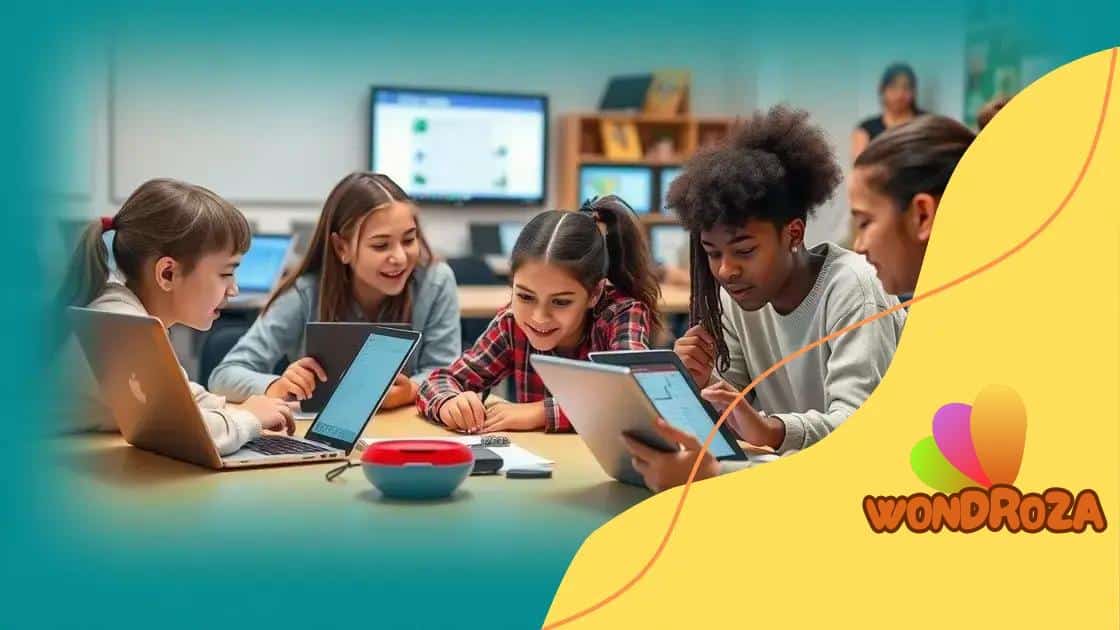The impact of virtual classrooms on student collaboration

The impact of virtual classrooms on student collaboration includes enhanced communication, personalized learning experiences, and increased engagement, while also presenting challenges such as technical issues and communication barriers.
The impact of virtual classrooms on student collaboration is reshaping how students communicate and work together. Have you noticed how technology can bridge gaps between individuals across distances? Let’s dive into this exciting transformation.
Understanding virtual classrooms
Understanding virtual classrooms is essential in today’s educational landscape. They offer a new way for students to connect and learn, breaking down barriers of distance and time. In virtual classrooms, students engage with the material, classmates, and instructors through online platforms, making learning interactive and accessible.
Key Features of Virtual Classrooms
Virtual classrooms come with several characteristics that enhance the learning experience. Some key features include:
- Real-time interaction: Students can ask questions and participate in discussions instantly.
- Multimedia resources: Instructors use videos, presentations, and online tools to enrich lessons.
- Flexible scheduling: Class times can adapt to students’ needs, allowing for better work-life balance.
These features foster an engaging learning environment, enabling students to collaborate even when they are not physically together. Additionally, platforms often provide tools for group projects and activities, encouraging teamwork.
Benefits of Virtual Classrooms
There are numerous benefits associated with virtual classrooms. They can promote a sense of community among students, even from a distance. Getting accustomed to tech tools can also prepare students for the future job market. Moreover, virtual classrooms can be tailored to different learning styles, ensuring that everyone can succeed.
One of the exciting aspects of virtual learning is that it opens doors to students across the globe. For example, a student in Brazil can collaborate with a classmate in Spain on a project, bringing diverse perspectives into their work. This global interaction can enrich the educational experience and broaden cultural understanding.
Another clear advantage is the personalized pacing that virtual classrooms offer. Students often have the option to revisit recorded lectures and materials, allowing them to digest the information thoroughly on their own time. This flexibility in learning helps accommodate varying levels of understanding among peers.
Benefits of collaboration in virtual settings
Collaboration in virtual settings offers many advantages that enhance the learning experience. As students work together online, they develop important skills that are valuable in both education and future careers. Let’s explore some benefits of this collaborative approach.
Enhanced Communication Skills
In virtual classrooms, students communicate through various digital platforms. This helps them learn how to express their ideas clearly using different tools. Effective communication in a virtual setting can lead to strong friendships and improved teamwork in projects.
- Instant feedback: Students can receive real-time responses from peers and teachers, which fosters understanding.
- Diverse perspectives: Working with classmates from different backgrounds allows students to explore various viewpoints.
- Practice in digital literacy: Young learners become familiar with online communication tools that are crucial in today’s job market.
As students collaborate online, they can feel more connected despite physical distances. This sense of community can boost their confidence and motivation. When students support each other, they often achieve better results.
Increased Engagement
Virtual collaboration encourages students to participate actively. With team projects and group discussions, they stay engaged and excited about learning. Students often find that working together makes challenging subjects easier and more enjoyable.
Mutual support and brainstorming lead to creative problem-solving. For instance, a group project where students combine their strengths can yield impressive results. When individuals bring their skills together, they can find solutions that they may not have discovered alone.
Moreover, collaboration helps students develop critical thinking skills. They learn to analyze information, ask questions, and challenge each other’s ideas respectfully. This kind of interaction prepares them for real-world challenges in their future careers.
Tools that enhance student interaction

Tools that enhance student interaction are vital in a virtual classroom. They promote engagement and collaboration among learners, making the educational process more effective and enjoyable. Utilizing the right tools can lead to dynamic learning experiences.
Communication Platforms
Various communication platforms allow students to connect effortlessly. These tools help facilitate discussions and collaborative work, bringing learners together in real-time.
- Video conferencing software: Applications such as Zoom and Google Meet enable live interactions, allowing students to see and hear each other.
- Chat tools: Platforms like Slack and Microsoft Teams provide chat functions where students can ask questions and share ideas instantly.
- Discussion boards: These allow classmates to post questions and replies, encouraging ongoing conversations outside of class hours.
When students utilize these platforms, they build a sense of community and trust, essential for effective collaboration. This environment fosters better communication skills and relationships among peers.
Collaborative Tools
In addition to communication platforms, there are many collaborative tools designed to enhance group work. These tools streamline project management and encourage creativity among students.
- Shared documents: Google Docs and Microsoft Office 365 allow multiple users to edit a document simultaneously, making collaboration seamless.
- Project management apps: Tools like Trello and Asana help students organize tasks and track progress on group projects.
- Presentation tools: Platforms like Prezi and Canva enable students to create visually appealing presentations together.
Using these collaborative tools helps students develop skills they will use in their future careers. Teamwork and project management experiences gained in the classroom can be invaluable as they enter the workforce.
Moreover, these tools allow for feedback exchange. Students can easily share their work and receive constructive criticism, fostering improvement and creativity.
Challenges in virtual collaboration
Challenges in virtual collaboration can impact the effectiveness of online learning. While technology allows for connections across distances, it also presents unique hurdles that students must navigate to succeed. Understanding these challenges is essential for creating solutions.
Technical Issues
One of the primary challenges in virtual collaboration is technical issues. Problems with internet connectivity can disrupt learning experiences, making it difficult for students to engage.
- Slow internet speeds: This can lead to lagging video and audio, making communication ineffective.
- Software glitches: Bugs or crashes in collaboration tools can cause interruptions during group work.
- Device compatibility: Not all students have access to the latest technology, which can create imbalances in participation.
When these technical obstacles arise, it can be frustrating for everyone involved. These issues remind us of the importance of having reliable technology available for all students.
Communication Barriers
Effective communication is essential for successful collaboration. However, in a virtual environment, students may struggle to share their ideas clearly. Lack of non-verbal cues can lead to misunderstandings among group members.
Another barrier is the difference in schedules. With students in various time zones, scheduling meetings can become complicated. These factors can hinder collaboration, making it harder for teams to work effectively.
Furthermore, changes in dynamics can occur in virtual environments. Students may feel less comfortable sharing their thoughts openly when they are not physically present. These dynamics can impact group cohesion and engagement.
To overcome these communication barriers, it’s crucial to establish guidelines for respectful dialogue. Encouraging active listening and using clear language can significantly improve interactions among students.
Adapting to these challenges requires teamwork and flexibility. Students need to embrace change as they learn to collaborate in a virtual setting, encouraging one another along the way.
Future trends in online education
The future trends in online education are shaping the way students learn and interact in virtual classrooms. As technology evolves, so do the methods and tools that educators use to engage learners. Understanding these trends helps prepare students for what lies ahead in their educational journeys.
Personalized Learning
One significant trend is the move toward personalized learning experiences. With the help of technology, educators can tailor lessons to meet the individual needs of each student. This approach helps students learn at their own pace, allowing them to focus on areas where they need improvement.
- Adaptive learning platforms: These platforms adjust the learning materials based on student responses, ensuring they get the right level of support.
- Customizable learning paths: Students can choose courses that align with their interests and goals, creating a more engaging educational experience.
- Data-driven insights: Teachers can use data analytics to monitor progress and adjust instruction accordingly.
This trend promotes higher levels of motivation and engagement among students as they feel more in control of their learning journeys.
Increased Use of Artificial Intelligence
Another emerging trend is the increased use of artificial intelligence (AI) in education. AI tools can analyze learning patterns and provide feedback to both students and teachers. These advancements streamline administrative tasks, allowing educators to focus more on teaching.
For example, AI-driven chatbots can assist students with common questions, providing immediate support. Additionally, intelligent tutoring systems can offer personalized assistance based on individual student needs, making learning more efficient and effective.
The integration of AI in online education can lead to enhanced learning efficiency and better outcomes for students, making it a promising element for the future.
Moreover, virtual and augmented reality technologies are set to make significant strides in online learning. These technologies provide immersive learning experiences that can enhance understanding and retention of complex subjects.
Focus on Soft Skills Development
As education shifts, there is also a growing focus on developing soft skills, such as communication, collaboration, and critical thinking. Online platforms are incorporating activities that help students build these essential skills.
Team-oriented projects and discussions encourage students to work together and learn from each other. This not only improves their understanding of academic content but also prepares them for the workforce where these skills are highly valued.
In conclusion, the trend toward virtual classrooms has transformed education. This shift has offered unique opportunities and challenges in student collaboration. By embracing technology, educators and students can enhance learning experiences. As we look to the future, tools like AI and personalized learning will play a key role in shaping how education unfolds. It’s essential for students to develop essential skills for success in a rapidly changing world, where collaboration and communication are more important than ever.
FAQ – Frequently Asked Questions about Virtual Classrooms and Student Collaboration
What are the main advantages of virtual classrooms?
Virtual classrooms provide flexibility, accessibility, and opportunities for real-time interaction among students and teachers, enhancing the learning experience.
How can technology tools improve student collaboration?
Technology tools facilitate communication, allow for shared resources, and support group projects, making collaboration more effective and engaging for students.
What role does personalized learning play in online education?
Personalized learning tailors educational experiences to each student’s needs, helping them progress at their own pace and focus on areas that require more attention.
How can students overcome challenges in virtual collaboration?
Students can overcome challenges by establishing clear communication, being flexible with schedules, and utilizing technology effectively to build a collaborative environment.





